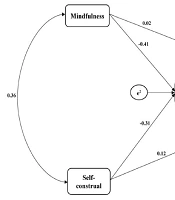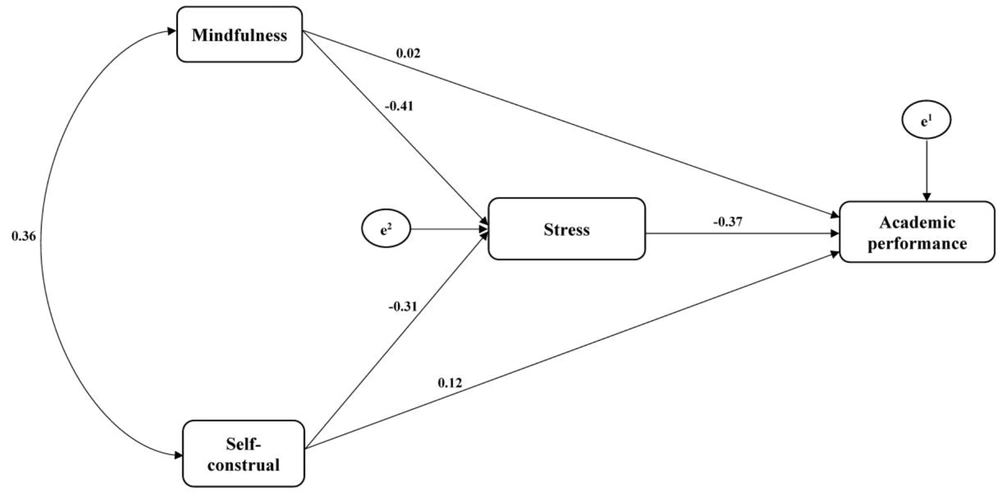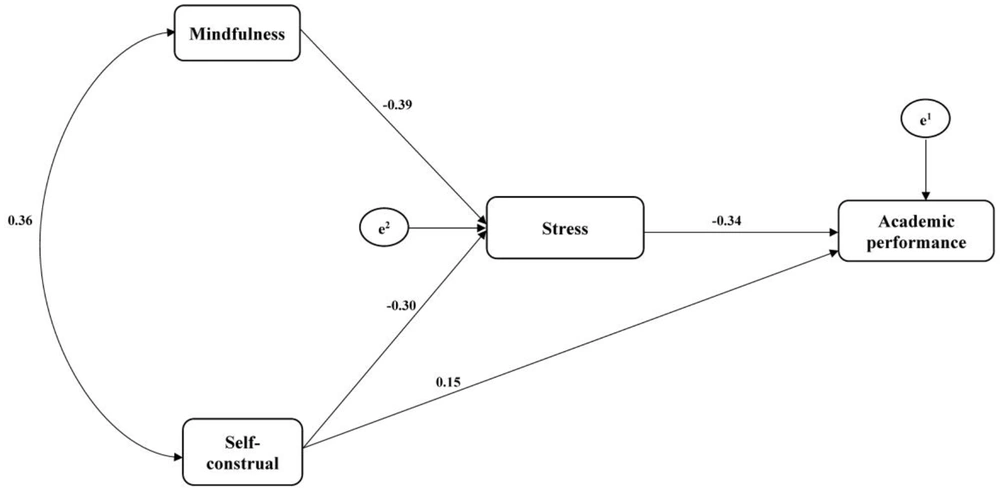1. Background
One of the main missions of higher education systems is to develop and train healthy, efficient, and committed individuals to fulfill personal, social, and occupational tasks (1, 2). An education system is considered efficient and successful when it guarantees the academic performance of students at various educational levels (3). Academic performance is a process that involves measuring, valuing, and judging a learner’s progress over time. Accordingly, performance is viewed as a critical strategic process that can influence the realization of social initiatives. In addition, it can ensure the effectiveness and efficiency of individuals from a procedural point of view (4, 5). The identification of the factors influencing the academic progress and performance of students can create a suitable basis for planning and developing educational programs to achieve the best possible outcomes in line with educational goals (6). A student’s academic performance is basically one of the most important and objective criteria for examining and evaluating the efficiency of educational systems. In fact, all efforts of this social system are focused on achieving this goal, especially among medical students who face high levels of stress (7, 8).
The relationship between cognition, excitement, and motivation is an important topic when studying students’ academic performance (9). Mindfulness, one of the cognitive factors associated with academic performance, is defined as being aware of all external and internal experiences in the present moment (10). As a lifestyle, mindfulness helps individuals familiarize themselves with the dual states of the mind and consciously employ them as an integrated entity through the meditation practices of daily life. Mindfulness helps individuals realize that they can not only think but also observe their thoughts (11). Like most skills, mindfulness improves with practice, and students who are trained for mindfulness skills can better focus on their tasks or lessons. Mindfulness can help students improve their reading habits and planning skills (12). Studies have shown a significant positive relationship between mindfulness and academic performance, noting that mindfulness can improve learners’ academic performance (11, 13).
Self-construal has been suggested as another factor influencing students’ academic performance. First proposed by Markus and Kitayama (14), the concept of self-construal has been increasingly used to predict and explain cultural differences in cognition, emotion, motivation, and communication. The underpinning idea of this concept is that there are two different types of self-construal, i.e., dependent and independent. Dependent self-construal considers that most previous identification methods are based on a personal-self model, in which identity is regarded apart from social roles and relationships regardless of how desires, capabilities, and goals are defined (15, 16). Meanwhile, independent self-construal is not integrated with self-performance description; instead, it explains self-description and offers oneself meaning in relation to others. Self-construal influences individuals’ behavioral, cognitive, and aesthetic styles, as well as their social interactions. In general, self-construal refers to how individuals define and give meaning to themselves, as well as how they see and define themselves in the community (17). Arabzadeh (7) found a significant positive relationship between self-construal and academic emotions, which could predict the academic adjustment of students.
Many studies have reported that the aforementioned factors, i.e., mindfulness and self-construal, can directly affect academic performance. However, this study seeks to find the mediating role of another factor (i.e., stress) in the association of mindfulness and self-construal with academic performance, a role that has been proposed by some researchers (8). Stress is defined as one’s inability to adapt to stressful situations and can seriously threaten the vital psychological and physical balance of the body (18). Stress can reduce students’ academic efficiency and performance and cause them to exhibit maladaptive behaviors, such as addiction to drugs or alcohol, in response to stressful situations (19). Students who are stressed out lack the necessary self-confidence to control their educational affairs (20). The most devastating effect of long-term stress is the disruption of effective functioning, thinking, and learning. It has been shown that stress can trigger physical and mental illnesses and also reduce students’ performance and adaptability (21). A significant inverse relationship has been noted between stress and academic performance among students, meaning that stress can lower students’ academic performance (22, 23).
Therefore, it can be acknowledged that the academic success of higher educational institutions, such as universities, is determined by their students’ academic performance or adaption to academic regulations. Several factors can affect students’ academic performance. Psychologists have long been interested in the effects of individual differences on academic success (24).
2. Objectives
Academic performance is now regarded as an important indicator of the performance of educational systems. Based on the mentioned background, the present study aimed to investigate the mediating role of stress in the relationship of mindfulness and self-construal with academic performance among medical sciences students.
3. Methods
This descriptive correlational study employed structural equation modeling (SEM) to examine the relationship between the target variables. The research population included all medical students of the Jondishapur University of Ahvaz, Iran, in 2022, 301 of whom were selected as the sample population by convenience sampling. The sample size was determined as n = 300 based on the research variables, and taking into account the possibility of dropping out, a total of 330 questionnaires were distributed among the students. A total of 29 of the questionnaires returned were excluded from the final analysis due to incomplete information. Inclusion criteria were an agreement to give informed consent and being at least a sophomore and exclusion criteria were unwillingness to continue the study and filling out the research questionnaires incompletely. The students were assured that their information would remain confidential with the project managers.
3.1. Measurement Tools
In this study, the previous semester’s grade point average (GPA) was used to measure students’ academic performance. In addition, the Five Facet Mindfulness Questionnaire (FFMQ), the Self-Construal Scale (SCS), and the Student Stress Questionnaire were used to measure the respective research variables. The FFMQ is a 15-item questionnaire developed by Baer et al. (25). These items are scored based on a 6-point Likert scale (from 6 = almost always to 1 = almost never). The minimum and maximum scores on this tool are 15 and 90, respectively, and higher scores indicate higher levels of mindfulness. Cronbach’s alpha coefficient of the Persian version of this questionnaire was reported as 0.78 (26). In the present study, Cronbach’s alpha of this tool was obtained as 0.83.
The SCS was developed by Hardin et al. (27). This scale consists of 30 items that measure 6 factors, of which four factors are related to independent self-construal. The items are scored based on a 7-point Likert scale (from 1 = totally disagree to 7 = totally agree). The total score of this scale ranges between 30 and 210, and higher scores demonstrate higher levels of self-construal. Cronbach’s alpha coefficient of the Persian version of this scale was reported to be 0.88 (28). In the present study, Cronbach’s alpha was obtained as 0.79.
Student Stress Questionnaire is a 10-item instrument developed by Chen et al. (29). These items are scored based on a 5-point Likert scale (from 0 = never to 4 = sometimes), with higher scores indicating higher levels of stress. This questionnaire includes two subscales: Perceived helplessness (6 items) and perceived control (4 items). Content validity for 10 items of the Persian version of the questionnaire was between 0.78 and 0.99. Moreover, Cronbach’s alpha coefficients of the whole scale and the subscales of perceived helplessness and perceived control were 0.92, 0.90, and 0.87, respectively.
3.2. Statistical Analyses
The proposed model was evaluated by SEM in SPSS-26 and AMOS-24. Relationships between the research variables were examined using the Pearson correlation coefficient.
4. Results
Analysis of demographic data showed that the mean age of the participants was 20.17 ± 2.71 years. Moreover, 174 (58.81%) of the participants were female, and 127 (42.19%) were male. Among the participants, 163 (54.15%) students were in the pre-clinical phase of their academic course, and 138 (45.85%) students were studying the clinical internship phase. Table 1 presents the data’s descriptive statistics, including the mean, standard deviation, skewness, kurtosis, and Pearson correlation coefficient. The Pearson correlation coefficient showed a significant correlation between all variables. Figure 1 displays the initial model developed for explaining academic performance based on mindfulness, self-construal, and stress.
| Variables | Mean ± SD | Skewness | Kurtosis | 1 | 2 | 3 | 4 | 5 | 6 |
|---|---|---|---|---|---|---|---|---|---|
| 1- Academic performance | 16.57 ± 1.02 | -0.03 | -0.15 | 1 | |||||
| 2- Mindfulness | 57.61 ± 7.44 | 0.12 | -0.69 | 0.26 a | 1 | ||||
| 3- Self-construal | 140.53 ± 16.86 | -0.09 | -0.57 | 0.30 a | 0.36 a | 1 | |||
| 4- Stress (total) | 29.72 ± 12.23 | -0.14 | -1.21 | -0.40 a | -0.48 a | -0.42 a | 1 | ||
| 5- Perceived helplessness | 17.87 ± 7.83 | -0.17 | -1.29 | -0.38 a | -0.47 a | -0.40 a | 0.96 a | 1 | |
| 6- Perceived control | 11.85 ± 5.24 | -0.12 | -1.48 | -0.36 a | -0.42 a | -0.38 a | 0.90 a | 0.74 a | 1 |
Mean, Standard Deviation, Skewness, Kurtosis, and the Pearson Correlation Coefficient of Academic Performance, Mindfulness, Self-construal, and Stress
As shown in Table 2, since the root mean square error of approximation (RMSEA) was equal to 0.131, the initial model required modification. Therefore, the path of mindfulness to academic performance was eliminated to increase the model’s goodness of fit. The final model shown in Figure 2 had an RMSEA of 0.077, indicating acceptable goodness of fit.
Table 3 shows the results of path coefficient estimation for examining direct relationships between the variables. The bootstrapping method was also employed to test the significance of mediatory relationships (Table 4). The results demonstrated that stress had a significant mediating indirect role in the relationship of mindfulness and self-construal with academic performance.
| Path | Initial Model | Final Model | ||
|---|---|---|---|---|
| β | P | β | P | |
| Mindfulness to academic performance | 0.02 | 0.735 | - | - |
| Self-construal to academic performance | 0.12 | 0.045 | 0.15 | 0.014 |
| Mindfulness to stress | -0.41 | 0.001 | -0.39 | 0.001 |
| Self-construal to stress | -0.31 | 0.001 | -0.30 | 0.001 |
| Stress to academic performance | -0.37 | 0.001 | -0.34 | 0.001 |
Direct Paths Between Academic Performance, Mindfulness, Self-construal, and Stress in the Initial and Final Models
| Predictor Variables | Mediator Variable | Criterion Variable | Initial Model | Final Model | ||
|---|---|---|---|---|---|---|
| β | P | β | P | |||
| Mindfulness | Stress | Academic performance | 0.15 | 0.001 | 0.02 | 0.001 |
| Self-construal | Stress | Academic performance | 0.11 | 0.001 | 0.01 | 0.001 |
The Analysis of Indirect and Intermediary Paths in the Final Model
5. Discussion
The present study aimed to investigate the mediating role of stress in the relationship of mindfulness and self-construal with the academic performance of medical sciences students. The results showed that the relationship between mindfulness and academic performance was not statistically significant. This was inconsistent with the results of previous studies (9, 11). Most previous studies have used regression analysis and the Pearson correlation coefficient to examine the relationship between these variables. In this study, Pearson’s correlation coefficient revealed a significant relationship between the mentioned variables, but due to the presence of a mediator variable, the SEM results indicated that “stress” could mediate the entire path from “mindfulness” to “academic performance”. To explain this finding, it can be stated that mindfulness enables individuals to recognize and learn their abilities, cope with negative emotions and thoughts, and have a positive experience with mental events (11). However, medical students seem to acquire good academic progress without the need for mindfulness since they use other methods for academic development.
Another finding of ours was a significant relationship between self-construal and academic performance, meaning that higher levels of self-construal were expected to increase the academic performance of students. This was consistent with the results of Arabzadeh (7), who reported a significant positive relationship between self-construal and academic performance in predicting the academic adjustment of students. To explain this finding, one should note that students with independent self-construal tend to organize other people’s thoughts, feelings, and actions and are less influenced by others. Individuals with dependent self-construal, however, find themselves as members of a social network and organize their behaviors based on social relationships and their perception of the thoughts, feelings, and actions of others. Previous studies have shown that the main traits of individuals with dependent self-construal include flexibility, empathy, adaptability, self-restraint, and compliance with social contexts (15). On the other hand, academic performance encompasses the motivation to learn, planning for scientific activities, a sense of commitment, communication skills, perseverance in educational and learning matters, and satisfaction with the atmosphere of the university entrance exam and the overall educational environment (7). As a result, a close relationship between dependent self-construal and academic performance can be perceivable.
Our results also demonstrated a significant inverse relationship between stress and academic performance. This finding was consistent with the results of Tingaz et al. (22) and Sharma & Kumra (23). To explain this finding, it can be argued that stress can reduce academic efficiency and performance, and students may respond to stressful situations by maladaptive behaviors, such as addiction to drugs or alcohol (8). Students are exposed to various sources of stress, such as separation from the family, financial problems, homesickness, disinterest in their academic major, insufficient welfare facilities, and educational problems, all of which can disrupt their general health and stress them out (30). Aside from the stressors imposed by theoretical educational courses, medical students may also face stressful clinical situations in hospitals. These stressful situations can hinder students’ educational achievements and effectiveness (8).
Another finding of the present study indicated that stress contributed a substantial mediatory role in the relationship between mindfulness and academic performance. Although no significant relationship was noticed between mindfulness and academic performance at first, analysis for the indirect relationship showed that mindfulness could positively affect academic performance only after a reduction in stress. Mindfulness is supposed to decrease stress and improve academic performance in students. On the other hand, a variety of other factors can positively or negatively influence the academic performance of medical students (31). Stress, which can be mitigated by mindfulness, is one of the factors that negatively affect the academic progress and performance of students. In fact, mindfulness improves both learning and future-oriented skills. It can be concluded that stress can effectively modulate the relationship between mindfulness and academic performance.
Our results also demonstrated that stress significantly modulated the relationship between self-construal and academic performance. The findings showed a significant direct relationship between self-construal and academic performance. However, the indirect hypothesis demonstrated that self-construal improved the academic performance of medical students by reducing their stress. Students with independent self-construal tend to organize other people’s thoughts, feelings, and actions and are less influenced by others. Individuals with dependent self-construal, however, find themselves as a member of a social network and organize their behaviors based on social relationships and perception of the thoughts, feelings, and actions of others. Therefore, it can be concluded that stress can play a substantial mediatory role in the relationship between self-construal and academic performance.
One limitation of this study was that the fact that students’ emotional and psychological states while completing the questionnaires could have influenced their responses. Furthermore, the academic performance of the participants was assessed based on their self-reported GPAs, the accuracy of which could be under question. Another limitation was the use of self-report measurement tools, which could have influenced the accuracy of the participants’ reports due to social desirability bias. In addition, since this study was conducted on medical students of the Jondishapur University of Ahvaz, the findings should be generalized to students in other universities and regions with caution.
5.1. Conclusions
Our results confirmed that the proposed model had an acceptable goodness of fit and could be used for identifying the factors affecting the academic performance of medical students. It can also be regarded as a new scientific innovation and discovery helping to improve the academic performance of medical students. Since mindfulness, self-construal, and stress are learnable and controllable issues, it is recommended that families and experts further focus on these variables to improve the academic performance of medical students. In addition, authorities should nurture educational environments in a way that students can invoke their positive personality aspects and behavioral traits to improve their academic performance and self-construal and reduce their stress.


